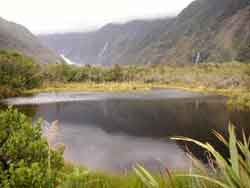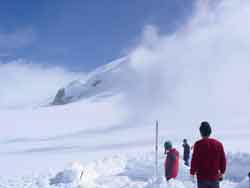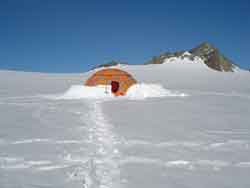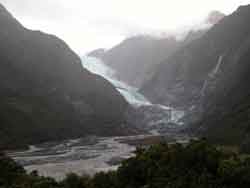Skip navigational links Abrupt Climate Change

This project is supported by a grant from NOAA, Office of Global Programs
Principal Investigators - George Denton and Paul Mayewski
Greenland ice cores register repeated abrupt changes in mean annual temperature, continental dust, and sea-salt during the last glaciation. These climate jumps are now known to have had an extensive geographic footprint in the Northern Hemisphere. Understanding the root cause of the spectacular abrupt climate changes of the last ice age is the most pressing problem of paleoclimatology. This puzzle has become even more complex with the realization that abrupt changes, although not as dramatic as those of the ice age, also occurred in the Holocene.
A test of any proposed explanation will require knowledge of the global impacts and magnitude of major abrupt changes. The Southern Hemisphere is absolutely crucial in this regard. Also of key importance is whether the trigger for widespread climate jumps lies in the atmosphere or in the ocean. Yet another unresolved issue is whether recurring millennial-scale oscillations served as the pacemaker for the repetitive abrupt events of the ice age.


Our research program addresses these issues that must be resolved in order to solve the problem of widespread abrupt climate change in a unique combination of ice core, moraine, chironomid and pollen studies. First, we will determine the relative phasing of different components of the climate system in the Northern Hemisphere during the abrupt jumps that dominated the Bolling/Allerod/Younger Dryas (B/A/YD) oscillation of late-glacial time. We will accomplish this task by measuring with new technology the various chemical species in the GISP2 ice core from Greenland. The results should help to clarify whether the trigger for abrupt change lies in the atmosphere or in the ocean. Second, we will determine if a classic B/A/YD signal is present or absent in middle latitudes of the Southern Hemisphere. Here our investigations will focus on the Southern Alps of New Zealand and on the South Patagonian Icefield in Argentina and Chile. The paleoclimatic signal will come from chironomid, pollen, and moraine proxies. The results should indicate whether the root mechanism for this late-glacial oscillation lies solely in the Northern Hemisphere or whether the tropics were a major player. Third, we will examine the anatomy of the Little Ice Age as revealed in ice cores from New Zealand, the South Patagonian Icefield, and Tibet. The Little Ice Age is the best example of the repeated climate pulses that may have paced abrupt changes in the ice age.
Expedition Pages:
Tasman Glacier 2003, 2004, Glacial New Zealand 2004, 2005 and Patagonia Ice Cores 2005





